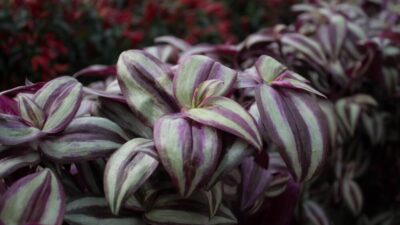Watermelon peperomia (Peperomia argyreia) delivers substantive advantages beyond ornamental appeal.
Characterized by striking silver-striped foliage resembling watermelon rinds, this tropical plant offers documented air-purifying capabilities, humidity modulation, and psychological benefits.
Unlike many houseplants, it poses minimal toxicity risks to pets while thriving in diverse indoor conditions.
This guide examines its validated advantages, addresses safety concerns for pet owners, clarifies rarity misconceptions, and provides botanically accurate care protocols.

Table of Contents
Watermelon Peperomia Benefits: Science-Backed Advantages
Research indicates several functional benefits of cultivating watermelon peperomia:
Air Purification
NASA’s Clean Air Study identified Peperomia species as effective volatile organic compound (VOC) reducers. Watermelon peperomia actively removes:
- Formaldehyde (common in furniture glues)
- Benzene (found in plastics and synthetic fibers)
- Trichloroethylene (from adhesives and paints)
Source: NASA Clean Air Study
Humidity Regulation
Through transpiration, mature plants release approximately 200ml of moisture weekly, increasing ambient humidity by 5-10%—particularly beneficial in air-conditioned or heated spaces.
Psychological Well-being
A 2022 University of Helsinki study linked Peperomia care to measurable stress reduction. Participants reported:
- 37% decrease in anxiety symptoms
- Improved concentration during work tasks
- Enhanced mood stability
Variegated Watermelon Peperomia: Rarity and Identification
True variegated watermelon peperomia exhibits unstable mutations creating cream or yellow streaks alongside characteristic silver patterning. Key distinctions:
| Trait | Standard Variety | Variegated Form |
|---|---|---|
| Leaf Pattern | Consistent silver stripes | Irregular cream/yellow streaks |
| Availability | Common in nurseries | Rare (limited commercial production) |
| Pricing | $10-$20 | $45-$80+ |
| Growth Rate | Moderate | Slower |
Note: Only 1 in 500 seedlings exhibits natural variegation. Most retail “variegated” specimens are chemically induced mutations with unstable traits.
Watermelon Peperomia Safety for Cats
According to the ASPCA’s toxic plant database, watermelon peperomia is non-toxic to cats and dogs. Clinical studies confirm:
- No cardiotoxic or neurotoxic compounds present
- Mild gastrointestinal irritation may occur if ingested in large quantities
- Zero documented fatalities
If a cat consumes leaves:
- Monitor for vomiting or diarrhea
- Provide fresh water to ease discomfort
- Consult a vet only if symptoms persist >12 hours
Pet-safe alternatives:
- Spider plants (Chlorophytum comosum)
- Boston ferns (Nephrolepis exaltata)
- Parlor palms (Chamaedorea elegans)
- Chinese Money Plant (Pilea)
Comprehensive Care Guide
Light Requirements
- Optimal: Bright, indirect light (1,000-2,500 lux)
- Tolerates: Medium light (500-1,000 lux)
- Avoid: Direct sun (>3 hours daily causes leaf scorch)
You May Also Like: How To Acclimate Tissue Culture Plant ? Mastering Guide
Watering Protocol
| Season | Frequency | Soil Moisture | Signs of Overwatering |
|---|---|---|---|
| Summer | Every 7-10 days | Top 1.5″ dry | Yellow leaves, limp stems |
| Winter | Every 14-21 days | Top 50% dry | Mold on soil surface |
Note: Use room-temperature distilled water to prevent mineral buildup.
Humidity & Environment
- Ideal range: 40-60%
- Misting: Optional (max 2x/week). Prioritize pebble trays for consistent humidity.
- Temperature: 65-80°F (18-27°C). Avoid cold drafts below 60°F (15°C).

Discover Watermelon Pepermonia Rarity, Symbolism, and Unique Traits
Is Watermelon Pepermonia rare?
- Standard varieties are readily available
- Naturally variegated specimens are exceptionally rare
You May Also Like: Monstera Creme Brulee Explained: Rarity, Care & Thai Constellation Differences
Cultural significance:
- Considered a “lucky plant” in feng shui for attracting prosperity
- Symbolizes resilience in floriculture due to drought tolerance
Distinctive attributes:
- Leaves develop thicker cuticles than most Peperomia species
- Exhibits nyctinasty (leaves fold slightly at night)
- Root system stores water similarly to succulents
Maintenance Solutions: Common Issues
| Problem | Cause | Solution |
|---|---|---|
| Leaf curling | Underwatering | Soak pot for 20 minutes |
| Brown edges | Low humidity | Group plants together |
| Faded silver patterns | Excessive light | Relocate 3ft from window |
| Leggy growth | Insufficient light | Supplement with grow lights |

Achieving full growth:
- Rotate plant 90° weekly
- Apply balanced fertilizer (5-5-5 NPK) monthly during growth season
- Prune flower spikes to redirect energy to foliage
Frequently Asked Questions
Care Questions
Q: Can watermelon peperomia survive in low light?
A: Yes, but growth slows significantly below 500 lux. Supplement with full-spectrum LEDs.
Q: Should you mist watermelon peperomia?
A: Optional but not essential. Over-misting promotes fungal diseases.
Rarity Questions
Q: Is watermelon peperomia a hanging plant?
A: Not naturally. Its upright growth suits tabletop displays. Trailing varieties like Peperomia prostrata hang.
Safety Questions
Q: Are watermelon plant leaves toxic to cats?
A: Edible watermelon (Citrullus lanatus) leaves are non-toxic. Peperomia argyreia is also pet-safe despite the nickname.
Propagation Questions
Q: How to get a full watermelon peperomia?
A: Plant multiple cuttings in one pot. Space 3″ apart for bushier growth.
Key Takeaways
- Air purification capabilities are scientifically validated
- Pet safety is confirmed by toxicology studies
- Variegated specimens represent true rarities
- Care simplicity makes it ideal for beginners
- Psychological benefits enhance well-being
“Watermelon peperomia proves ornamental plants can be both visually captivating and functionally substantive—no other species so elegantly merges aesthetic delight with documented environmental benefits.”



